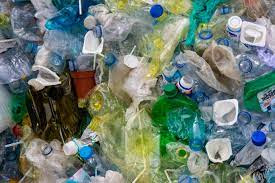THE DISADVANTAGES OF USING PLASTIC PRODUCTS
- Get link
- X
- Other Apps
THE DISADVANTAGES OF USING PLASTIC PRODUCTS
Plastic is everywhere
around us. It's used to make a lot of our furniture, clothes, gadgets, and food
packaging. Plastic has largely taken the place of natural materials used in
manufacturing, such as paper, glass, and cotton, over the previous few decades.
We are aware that the massive plastic contamination of our environment is a
result of the widespread usage of plastics. Plastics, though, are a problem
that extends beyond the environment. We are dealing with a human health issue
as well, as toxicologists.
Every day, we breathe,
consume, and drink microplastics. Once within our bodies, these tiny plastic
flecks could cause health problems.
Chemical fillers can be
found in plastic goods. Infertility, malignancies linked to hormones, and neurodevelopmental disorders including ADHD and autism have all been linked to a
number of these substances.
When plastics and microplastics enter the environment, they draw microbes like dangerous bacteria (pathogens). These pathogens may raise the risk of infection if microplastics carry them into our bodies.
Microplastics are
plastic granules that are 5 millimeters in size or smaller. Nanoplastics are plastics
that are even one million times smaller than a millimeter. Microplastics have
been discovered all across our ecosystem, including in the deepest ocean
tunnels, on both poles, and on top of the Himalayas. Microplastics can also be
discovered considerably closer to home, though. Microplastics are practically
ubiquitous in every home since they are discharged from our sofas, carpets,
curtains, and other synthetic textiles. Numerous consumer goods, including
seafood, honey, beer, water, salt, fruits, and vegetables have also been
discovered to contain microplastics.
We eat, drink, and breathe plastics every day as a result of plastics contaminating both our indoors and out accumulation of plastic debris in the environment is the main cause of plastic pollution. It can be divided into primary plastics, such as cigarette butts and bottle caps, and secondary plastics produced as a result of primary plastics degrading. Microplastics, which are tiny plastic particles (less than 5 mm) scattered throughout the environment, are one way to categorize them. Macroplastics, on the other hand, is another way. door environments. Bacteria thrive in plastics because they are not biodegradable. Animals are killed by waste after eating plastic objects, according to waste. Microplastics and plastic microbeads from cosmetic and personal care goods have arrived
Plastics are
large molecular mass synthetic polymers made of carbon and other elements.
Polymers are lengthy chains of monomers that are pliable and can also be formed
into solid objects. It is utilized in carrying bags, switches, utensils,
electrical lines, fire-resistant fabric, and boxes and packaging. Plastics are
generally lightweight and robust despite the wide variety of polymers. Plastics
can be pulled into textile fibers and molded, extruded, cast, blown, and cast
into an almost endless variety of shapes, films, and foams. Coatings, sealants,
and glues are also mostly composed of plastic.
Everybody's
blood and tissue contain toxic chemicals that leach out of plastic. Tumors,
birth abnormalities, weakened immunity, endocrine system disturbances, and
other illnesses are linked to exposure to them.
What are plastic's primary drawbacks?
A lot of the
hazardous chemicals and contaminants carried by the ocean are absorbed by
plastics like a sponge. When we decompose, we release these into the atmosphere
along with the chemicals that were employed to give them their characteristics,
like color, which can really be very dangerous.
How hazardous is plastic to humans?
Chemicals put into plastics are absorbed by human bodies. These compounds all have the potential to alter hormones or have other negative impacts on human health. Plastic can kill or injure wildlife.
When there is plastic contamination, toxic chemicals are released that affect people, animals, and plants. The long-lasting environmental harm is caused by the fact that it might take hundreds or even thousands of years for plastic to degrade. From tiny species like plankton to whales, it impacts all organisms in the food chain.
Is plastic
dangerous?
Almost
everyone's blood and tissue can contain toxic chemicals that seep out of
plastic. They are linked to cancer, birth abnormalities, weakened immunity,
endocrine disruption, and other diseases when exposed to them.
Plastics are
often not biodegradable, thus it could take a very long time for them to
decompose. The intermolecular connections that make up plastics, whose
structure prevents corrosion and decomposition, are to blame for this. Plastics
improperly disposed of wash into water reservoirs. They pollute and sully
reservoirs by floating on them and clogging up streams with them.
Plastics often
have a low melting point, making it impossible to use them in hot environments.
They cannot, therefore, serve as a barrier to safeguarding furnaces. Some plastic
goods, such as polystyrene, acrylics, polyethylene, and nylons, which are
frequently used in packaging and home and office equipment, are highly
flammable. They are a fire hazard as a result.
Comparatively
speaking to metals, plastics usually have a shorter useful life. Due to this
limited lifespan, undesired trash accumulates in the workplace, home, or
landfills. Although some plastics are recycled, the majority are left in dumps
where they contaminate the environment since they are not collected. In
addition, polythene bags are easily carried by the wind, which makes it
difficult to collect them for recycling.
- Get link
- X
- Other Apps





Comments
Post a Comment